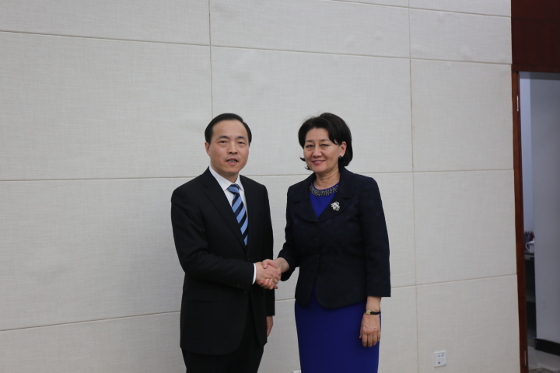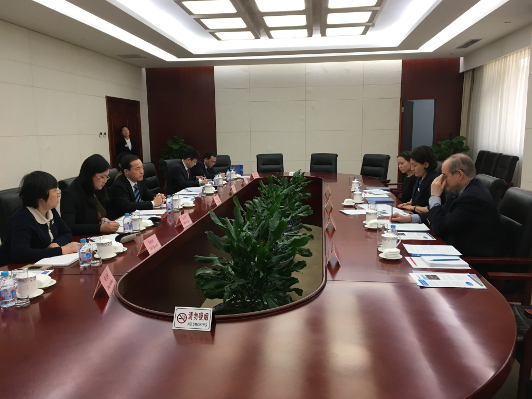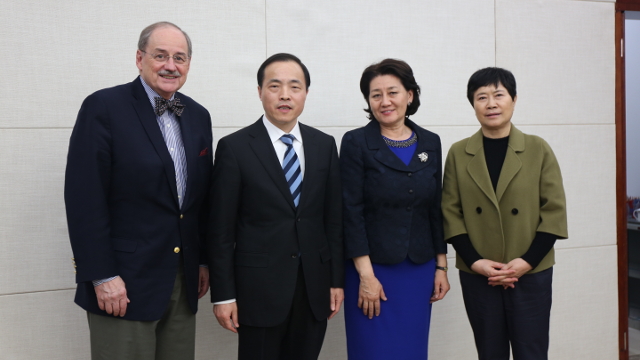The strategic growth of GWP from 2014 to 2019 is a challenge in view that the organisation must reach more remarkable outcomes upon a list of triumph in the past 20 years. While preparing the new GWP strategy from 2020, the top management team communicates and consults with powerful alliances around the world for more supports and efforts to the better development of GWP.

Vice Minister Xuewen Zhou & Dr Sanjaasuren met in Beijing
The leading reformer, Dr Oyun Sanjaasuren, GWP Chair flew to Beijing for her first meeting with the Ministry of Water Resources of China (MWR). Her commitment received an influential backing of Mdm Qihua Cai, Chair of GWP China & former Vice Minister of MWR. The Ministry leaders hosted a meeting and reception dinner for Dr Sanjaasuren and the delegation of GWP on Wednesday.
Dr Xuewen Zhou, Vice Minister who oversees the international cooperation and strategic planning in the Ministry, had a fruitful communication with Dr Sanjaarsuren. Communal missions on water development helped them reach consensus on various areas at global, interregional, regional and national levels. On Dr Sanjaarsuren, China is more competent in the knowledge and practice of the integrated water resources management (IWRM) which are valuable learning resources for other regions in the world. She also respected the long-committed contribution of the Ministry to GWP China and GWP whole network. With the loyal patronage of MWR, GWP China has an enduring influence on promoting and implementing IWRM which lays at the foundation of GWP.
According to Vice Minister Zhou, China has a vast territory that varies in landscape and climate which has taught Chinese a chunk of experiences and methodologies to address water-related challenges. He agreed with Dr Sanjaarsuren that China’s understandings on complicated water issues, e.g. scarcity, pollution, disasters and prevention, should open to more regions and countries for communications and exchanges. Both leaders held that GWP China plays a constructive role in promoting IWRM at each level through diverse activities that convene multiple stakeholders for equal and open dialogues, provide them with efficient capacity buildings, and publish supportive knowledge products. Mutual trust and profound understanding between GWP and MWR form a steady relationship that has profited nature and people upon the global network of GWP which contains 3000+ partners from government, the private sector and civil society in 183 countries. 13 regional and 61 national water partnerships of GWP are the most effective engine to drive the progress of the Belt and Road Initiative forward. GWP has multiple levels that enable all stakeholders to work closely, said Dr Sanjaarsuren, 65 countries in the GWP network intersect with “the Belt and Road Initiative”, and connect Regional Water Partnerships in Africa, Asia, Europe, and Latin America.

Leaders of GWP visited the Ministry of Water Resources of China
It’s more impressive for MWR that GWP has played an essential part in the implementation of national development strategies, the 2030 Agenda with a notable contribution to the SDG 6, and the transboundary coordination that facilitated the Lancang-Mekong Water Cooperation Centre to extend relationships with associated countries through the teamwork of GWP in Asian regions.
Cover photo: key leaders of two parties
(left-right) Jerry Priscoli, Xuewen Zhou, Oyun Sanjaarsuren, Qihua Cai
